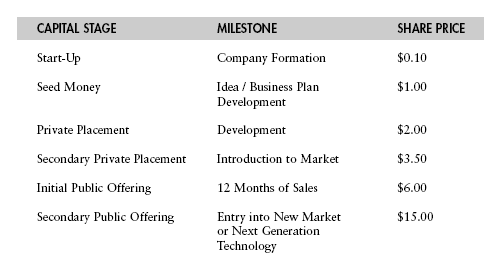 When Prevention is Better Than Cure: When Prevention is Better Than Cure:
Planning Your Company’s Capital Structure
By Mark W. Sheffert
October 1999
If you’re a typical entrepreneur, your time is spread between many roles including the
human resources director, finance director, marketing director, etc. Planning your future
capital structure today probably doesn’t seem important when your idea of setting
priorities is figuring out how to meet the mortgage payment on Friday.
But decisions made today about your cap Deciding how much capital to raise and
when to do it is a common dilemma for many entrepreneurs. You have to find the right
place just between too much and not enough, too early and too late. Too much outside
capital into a start-up company will create excessive dilution for shareholders in later
years. But a lack of capital during growth years can hinder efforts to capture market
share or introduce new technology ahead of the competition.
Most small business owners who have had to raise outside capital have learned
that the availability and costs of capital depended upon their company’s particular stage
of growth. Start-ups have a difficult time finding investors or getting bank loans, and
resort to using personal credit cards at 18-20% interest. Then, a number of years later
when you are successful beyond even your own dreams, investors beat down your door
to buy your company with offers difficult to resist.
Whatever stage you’re in, you should know there is money available for
companies in all different growth stages, but that you will be more successful in attaining
it if you understand the various stages of capitalization and plan accordingly. Each stage
in the "capitalization maturity process" generally coincides with a company milestone
such as the development of a prototype or geographic expansion of your distribution
system. And, as time progresses, the price of buying equity in your company increases
with each milestone, as this example of a fictitious company’s capitalization maturity
process demonstrates:

In the simplest terms, your strategy should be to raise the least amount of money
possible in your company’s early stages of growth and raise the most in later stages.
Why? So you can avoid excess dilution in the early stages as every share sold will
eventually dilute future earnings per share. At the same time, it is important to avoid
under-capitalization --- companies with weak capital structures don’t have room to
recover from a mistake or have revenues below your budget. And as time goes on and
you can create a higher level of value for your stock, you should raise as much as you
can for the least amount of effort.
The first stage in the capital maturity process is start-up. The start-up of a new
business is highly risky because it really only exists in your imagination, and its success
depends upon your personal experience and ability to turn opportunity into reality.
Banks prefer companies with a track record of performance, and investors generally
aren’t willing to put money into dreams, so founders themselves finance most start-up
businesses through personal savings, credit card debt, or home equity loans.
Seed money is the second stage, typically to pay for expenses to get your idea off
the ground. After they’ve exhausted their own resources, many entrepreneurs get loans
from their family and friends. The advantage is that you’ll probably get better terms
than you would with a bank. The disadvantage is that owing money to your family and
friends can make family picnics pretty dicey!
Traditional banks are typically not interested in financing companies in this
stage because you are still viewed as "non-performing". A more common source of
early-stage funding is loan guarantees secured by the Small Business Administration
(SBA), whose purpose is to assist new and established small businesses. Although the
SBA oversees the programs from their offices in Washington, D.C., commercial lenders
across the country that are licensed by the SBA issue the loans and handle the paperwork. Terms of a traditional commercial loan are payment within one to three years,
while terms of an SBA guaranteed loan can be from three to ten years (ie, lower monthly
repayment expenses for you).
Another Option - Angels
When your company has reached its next major milestone (the development of a
prototype, for example) it’s time for a private placement. This is a sale of securities
(equity, debt or convertible debt) to an investor or group of investors without a
registered public offering. These investors may be venture capitalists (funds with pools
of money to invest in early stage companies) or angel investors (individual wealthy
investors).
The advantages of a private placement of equity are that, unless a dividend is
guaranteed, there is no drain on cash flow, and for balance sheet purposes, the
company’s net worth and book value are enhanced because stockholders’ equity is
treated separately from liabilities. The advantages of a private placement of debt is
that you may be able to get interest rates that are lower than those with a traditional
commercial bank, and your investors may provide more lenient default terms.
With the good comes the bad. The disadvantage of a private placement is that
you are selling ownership in the company and are therefore diluting the percentage of
ownership for existing shareholders. (However, the value of their shares should be
enhanced in the long-term if the equity is used to enhance the company’s operations and
results in increased earnings per share.) Also, angel investors and venture capitalists are
not typically silent partners, but will want to have some input and control over your
operations.
As your company grows and reaches its next milestone, such as hiring a sales
force to take your product to market, you may need more rounds of private equity,
called secondary private placements. It is not uncommon for small growing companies
to raise several rounds of private equity.
When it is time to raise large amounts of cash for a major business expansion,
new product development, or to liquefy investor’s positions, it’s time to plan an initial
public offering (IPO). The IPO process will result in your company’s stock being listed
on a stock exchange to be publicly traded and allow anyone to buy or sell shares in your
company.
Going public is a lengthy, complex, expensive process that could take about as
long as a year from start to finish. You will need to work with an investment banker,
accountants, attorneys, and a public relations firm to draft the necessary documents, get
approvals from the Securities and Exchange Commission and your stock exchange, and
present your story to investors during a road show. Your hard work will result in large
amounts of cash raised in your IPO, and also offer liquidity for your previous investors,
who can now cash in on their previous investments on the public market.
As your company continues to grow and mature, it may require a secondary
public offering to raise cash for development of next-generation technology or to open
international offices, for example, or to acquire competitors to gain products, markets,
or distribution.
As you plan your capitalization maturity process from start-up to a secondary
public offering, make sure to project the cost of buying stock in your company to rise as
time passes and the value of your company rises. In my fictitious example, an investor
buying one share during the company’s start-up stage would pay only $0.10 per share.
As the value of the company increased with each major milestone, the cost per share rose
to $15.00 per share in the secondary public offering.
- In every stage, your objectives in raising outside capital should be:
- The most capital for giving up the least equity
- The greatest freedom possible from investors
directing the company’s operations
- The easiest path
- The opportunity for investors to make a fair return
on their investment and to gain liquidity to harvest their gains
The road through growth stages can be paved with gold or full of bumps and
detours. Planning your capital structure to coincide with your growth stages should be
an important part of your ongoing business planning efforts, and may help you find
some golden pavement.
Back to Top |



